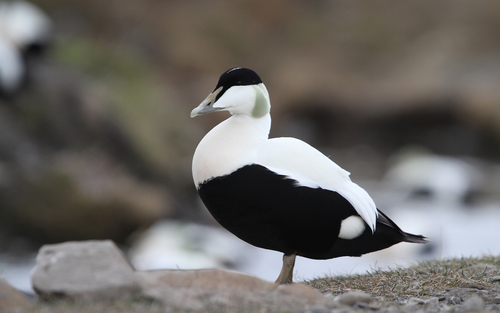
Common Eider
The Common Eider (*Somateria mollissima*) is a large sea duck renowned for its exceptionally soft and insulating down feathers, which have been historically harvested for use in bedding and clothing. This species plays a crucial role in coastal ecosystems, primarily as a consumer of benthic invertebrates. It holds cultural significance in many Arctic regions, where eiderdown harvesting has been a traditional practice for centuries, often managed sustainably by local communities. The Common Eider is a striking example of adaptation to harsh, cold marine environments.
50-71 cm
Length
80-110 cm
Wingspan
Near Threatened
Conservation Status
Distribution
Circumpolar distribution in the Northern Hemisphere. Breeds along Arctic and subarctic coastlines of North America, Europe, and Asia. Migrates south for winter, reaching temperate zones, but generally staying in cold, marine waters. Altitudinal range is limited to coastal areas.
Lifespan
Up to 20 years in the wild, though average lifespan is likely shorter.
Common Eider's Habitat
Habitat Types
Rocky coastlines, Islands, Tundra pools, Estuaries, Shallow coastal waters
Climate Zones
Arctic, Subarctic, Temperate (wintering)
Adaptations
Dense down feathers provide exceptional insulation against cold water and air temperatures. Salt glands above the eyes allow them to excrete excess salt, enabling them to drink seawater.
Variations
Several subspecies are recognized, differing slightly in size and plumage, such as *S. m. mollissima* (Europe), *S. m. borealis* (North Atlantic), and *S. m. v-nigrum* (Pacific).
Appearance
Breeding Plumage
Males have striking breeding plumage: black and white body with a green nape and a distinctive pale green patch on the side of the head. Females are brown with barring for camouflage. In non-breeding plumage (eclipse), males resemble females but retain some white on the wings.
Seasonal Feather Changes
Males molt into eclipse plumage after breeding, then back into breeding plumage in late fall/winter.
Sex Based Plumage Differences
Significant sexual dimorphism in plumage, especially during breeding season.
Notable Features
Large, wedge-shaped bill, Sloping forehead, Dense down feathers, Males have a green patch on the nape.
Diet and Feeding
Primary Foods
Mussels, Clams, Crabs, Sea urchins, Other marine invertebrates, Small fish (occasionally)
Foraging Behavior
Dives underwater to forage on the seabed, typically in shallow waters. Uses its strong bill to pry shellfish from rocks or dig in the sediment.
Specializations
The bill is adapted for handling hard-shelled prey. They can swallow mussels whole and crush them in their gizzard.
Seasonal Diet Variations
Diet may shift slightly depending on prey availability, but generally consists of benthic invertebrates year-round.
Behavior
Social Structure
Forms large flocks outside of the breeding season. During breeding, females often nest in colonies, while males gather in separate groups.
Communication
Soft cooing calls (males during courtship), Quacking calls (females), Visual displays (head movements, wing flapping)
Migration
Many populations are migratory, moving south from Arctic breeding grounds to winter in more temperate coastal waters. Some populations are resident or only partially migratory.
Territorial or Group Behaviors
Females may defend a small area around their nest. Males do not defend territories but compete for access to females.
Conservation
Threats
Habitat loss and degradation (coastal development), Oil spills and pollution, Climate change (sea level rise, changes in prey availability), Overfishing (reducing food sources), Hunting (in some regions), Disturbance at breeding colonies
Protection Programs
Monitoring of breeding populations, Habitat restoration and protection, Regulations on hunting and eiderdown harvesting, International agreements for migratory bird conservation
Local National Laws
Protected under various national and international laws, including the Migratory Bird Treaty Act in the US and Canada, and the Birds Directive in the EU.
Population Trend
Decreasing
Population Estimates
Global population estimated at 3.5 - 4 million, but with significant regional variations and declines.
Interesting Facts
Eiderdown is one of the best natural insulators.
Its unique structure traps air very effectively, providing exceptional warmth.
Females fast during incubation.
They rely on stored fat reserves and rarely leave the nest.
Common Eiders can dive to depths of up to 20 meters.
To reach their preferred food sources on the seabed.
Creches, or groups of ducklings, are often cared for by multiple females.
This cooperative behavior is seen in some eider colonies.
The scientific name, *Somateria mollissima*, means 'very soft woolly body'.
This is a reference to the bird's famous down.
Faqs about Common Eider
What is eiderdown used for?
Eiderdown is primarily used as filling for duvets, pillows, and high-quality outerwear due to its exceptional insulating properties.
How is eiderdown harvested?
Traditionally, eiderdown is collected from nests after the chicks have hatched. Sustainable harvesting practices involve taking only a portion of the down and leaving enough for the nestlings. In some areas, artificial nest shelters are provided to encourage nesting and facilitate down collection.
Are Common Eiders endangered?
The Common Eider is currently classified as Near Threatened by the IUCN. While some populations are stable, others are declining due to various threats.
Do Common Eiders mate for life?
Common Eiders do not typically mate for life. Pair bonds generally last for a single breeding season.
How can I tell the difference between a male and female Common Eider?
During breeding season, males are easily distinguished by their black and white plumage and green nape. Females are brown with barring. Outside of breeding season, males are in eclipse plumage and more closely resemble females, but still retain some white on the wings.
Copyright @ Nature Style Limited. All Rights Reserved.
 English
English